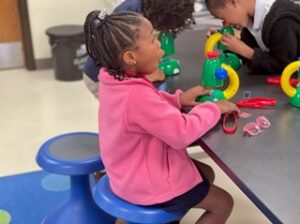In 2011, STEM initiatives first took root in the southern sector of Dallas County. Students that were entering school that year, just children at the time, are now set to graduate high school and enter the next stage of their life. Needless to say, a lot has changed for students, educators, and the community since this initiative began.
Satisfying an appetite for change in southern Dallas County
College and career pathways are raising students’ expectations. Professional development is equipping educators to focus instruction on 21st century skills. And a home-grown pool of workforce talent is fueling job opportunities by further strengthening the business landscape. For Educate Texas and its funding partner, Texas Instruments Foundation, the hunger for change that they saw within the Lancaster Independent School District made all the difference in knowing where to start.
Changing communities, untapped opportunities
TI Foundation Executive Director Andy Smith explained that prior to the initiative, there was no grant money to speak of in southern Dallas County school districts—where more than one-third of residents live in poverty and students lack the academic advantages of those in more affluent Dallas County districts. “Equity in education notwithstanding, southern Dallas County is growing and is becoming increasingly important to the local economy and our workforce needs,” Smith added.
That growth is evident in the gradual shift of farmland to industrial complexes, warehouse facilities, hospitals, and other developments. It’s also apparent in the housing market, which has been on the rise after years of stagnation. As the business sector grows, so do employment opportunities for those with the right knowledge and skills. And as the housing market grows, so does the public profile of local school districts — for better or worse.
For these reasons, Lancaster, DeSoto, and Cedar Hill school districts rose to the top in terms of opportunity. And in 2012, Lancaster ISD won a competitive grant to create the area’s first districtwide STEM program.
Lancaster: the perfect place to start
 “The reason Lancaster was the first district — they had a great recipe,” said Dr. Reo Pruiett, who led the initiative on behalf of Educate Texas. “The superintendent at that time was able to put together a team that was hungry for change in their area. He also believed in professional development for both the teachers and the staff. He also had a good relationship with the board.”
“The reason Lancaster was the first district — they had a great recipe,” said Dr. Reo Pruiett, who led the initiative on behalf of Educate Texas. “The superintendent at that time was able to put together a team that was hungry for change in their area. He also believed in professional development for both the teachers and the staff. He also had a good relationship with the board.”
Just as importantly, Dr. Pruiett said, the Lancaster community turned out in force to express their desire for change. “They were ready for their students to have a different quality of life,” she said. “The city government and the school district began to do more planning together. Instead of having a city plan and then a school plan, they both had elements of the same plan, which helped them to be reinforcing partners.”
Closing gaps and opening doors
The partnership between the TI Foundation and Educate Texas transformed Lancaster ISD into a STEM learning environment at every level, from pre-K through 12th grade.
 “Results were good, with math and science scores substantially improving, the state accountability rating improving from a D to a B, and learning gaps being closed, vs. the state average,” said Smith of the TI Foundation. “A later grant focused on reading, and helped to move scores higher.”
“Results were good, with math and science scores substantially improving, the state accountability rating improving from a D to a B, and learning gaps being closed, vs. the state average,” said Smith of the TI Foundation. “A later grant focused on reading, and helped to move scores higher.”
At the high school level, students are encouraged to pursue pathways designed to balance today’s needs and interests with tomorrow’s possibilities. For example, dual-credit courses, work-based learning, and other programs give students the option to earn college credit, certifications, and wages before they finish high school. Dr. Pruiett cited Lancaster’s pharmacy tech program as one example.
“They may get that certification at the end of 11th grade or 12th grade, and then they can earn and learn while they either decide to go on and pursue their two- or four-year degree — or, you know, life happens for families; they may need to continue the pathway of work,” Dr. Pruiett said. “And it is a career — a pathway to a career.”
Bold investments to change the narrative
To date, the TI Foundation has invested a total of $64 million in southern Dallas County, including $8 million to launch districtwide STEM programs in Lancaster and surrounding areas.
“We continue to stay true to our education funding strategy — investing in programs that grow the number of Black, Latino, and female high school graduates with strong math and science skills,” said Smith of the TI Foundation. “Their backgrounds and residential postal codes do not have to limit their potential.”
There have been challenges along the way, but stakeholders from Educate Texas and the TI Foundation remain committed to the process, holding regular meetings with the school board to discuss which targets they’ve hit, as well as strategies for accelerating or changing directions to achieve others. As Dr. Pruiett explained, the TI Foundation’s strong ties to the engineering discipline gave the team permission to admit when something wasn’t working and try another approach.
“One of the pieces that we learned early on was, they are engineers. So they are used to looking at a problem, finding multiple solutions, and then trying those solutions,” Dr. Pruiett said. “To have a powerful partner like TI (Foundation) to say, ‘OK, that didn’t work. What are you gonna do next?’ Instead of, ‘That didn’t work. I’m gonna cut you off.’ That was a huge change.”
Allocating funds to fit the needs
When most people envision what a STEM grant can do for their local school district, images of computer components, lab equipment, and specialized machinery may come to mind. Yet in today’s STEM environment, where the state now provides more money to handle many of the technology needs, grant money is typically earmarked for professional development, student support, and community outreach.
Grantee districts also receive support to develop recovery strategies to address pandemic learning loss, which hit school districts in southern Dallas County especially hard. Smith of the TI Foundation said test scores and attendance began trending upward again in 2022, however, and that Lancaster is again outpacing other districts with similar economic demographics in the journey back to pre-pandemic performance.
Interconnected communities
With Lancaster’s districtwide STEM program well underway, DeSoto and Cedar Hill received grants of their own in 2019, creating a cohesive multi-district STEM environment to keep the momentum going in an area where students tend to change school districts due to local moves.
“The students in Lancaster, DeSoto, and Cedar Hill —tend to be a mobile community. The kids may live in DeSoto first and second grade, they could live in another part third and fourth, and come back. They share a lot of the student population. So the conversation is not complete unless you talk about the three alignment pieces,” Dr. Pruiett said.
She also explained that each community has its own challenges that a cohesive multi-district STEM program can help to address.
“Lancaster had a desert in terms of healthcare. And then you have Methodist Hospital closer to DeSoto and Cedar Hill. But that hospital still needs people working in all areas of health sciences. So how can the three districts begin to work together? Could we increase pipelines in things such as healthcare? Could we increase in terms of, what are we doing for educator practices? Do we have a pipeline for ‘grow your own educators’? Because it’s getting harder to staff schools,” Dr. Pruiett said.
Dr. Usamah Rodgers, Superintendent of Schools for DeSoto ISD, underscored the shared value of these STEM grants.
“I believe the greatest opportunity to impact the southern Dallas County workforce is providing technical assistance and training for school leaders to upskill CTE (career and technical education) in preparing students to enter the pipeline for employment opportunities,” Dr. Rodgers said. “There is also the continued need to provide opportunities for students to be exposed to the industry, which assists in helping students visualize the possibilities for their future.”
A ripple effect of progress and possibility
 In the years since the first districtwide STEM grant was awarded in southern Dallas County, both individual and community success stories have emerged. For example, Lancaster graduated its first Gates Scholar and West Point Scholar. Parents have become more involved as well — not only in their children’s education, but also in their own. When parents took notice of the program’s momentum, Lancaster expanded their efforts to provide services like financial aid counseling and job application guidance for them as well.
In the years since the first districtwide STEM grant was awarded in southern Dallas County, both individual and community success stories have emerged. For example, Lancaster graduated its first Gates Scholar and West Point Scholar. Parents have become more involved as well — not only in their children’s education, but also in their own. When parents took notice of the program’s momentum, Lancaster expanded their efforts to provide services like financial aid counseling and job application guidance for them as well.
Dr. Pruiett mentioned that by giving students, teachers, administrators, and parents the tools to succeed, not every success story will remain local. Some will move on to other positions or places to continue their journey. And, while career moves that take educators or students away from the community are a bittersweet testament to the program’s success, Lancaster and the surrounding districts are now able to attract more applicants for the openings that do arise.
DeSoto’s Dr. Rodgers, who was hired in 2022, is among those who recognize the potential of the partnership with Educate Texas and the TI Foundation.
“This partnership is extremely invaluable because we would not be able to offer the programs, resources, and services provided without the grant funds or partnership,” Dr. Rodgers said, citing the district’s access to high-quality professional development, instructional resources, and STEM enrichment that the district would not be able to access on its own. “As a result, the district achieved double-digit gains in students’ math and science on STAAR during the previous academic year.”
As for Dr. Pruiett, her role with the initiative has also evolved over the years — from boots-on-the-ground leadership for Educate Texas to her current position as Chief Diversity, Equity, and Inclusion Officer for the Communities Foundation of Texas, the organization that oversees Educate Texas and its many initiatives. In both positions, Dr. Pruiett has seen the impact of ensuring that everyone has a seat at the table. These southern Dallas County initiatives are doing just that.
“That was something that nobody really saw communities of color doing was STEM. And it helped us raise our academic bar. And it also caused everywhere from pre-K through 12 for students to begin to experience STEM and STEM critical thinking at an earlier age than ever before,” Dr. Pruiett said. So I think those are some of the pieces that I would really speak to. Because it’s been a difference-maker.”
Systemwide STEM objectives
To learn more about these and other initiatives driving change in North Texas communities, visit edtx.org.



Educate Texas, an initiative of Communities Foundation of Texas, is the trusted change agent in education that is thinking bigger by proving solutions through programs and practices, instilling change through policy, and convening the right partnerships and networks for action.
OFFICES
407 N. 77 Sunshine Strip
Harlingen, Texas 78550
MAIN LINKS
INFORMATION